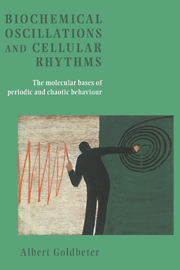Book contents
- Frontmatter
- Contents
- Foreword to the English edition by Michael Berridge
- Foreword to the French edition by Ilya Prigogin
- Preface
- 1 Introduction
- Part I Glycolytic oscillations
- Part II From simple to complex oscillatory behaviour
- 3 Birhythmicity: coexistence between two stable rhythms
- 4 From simple periodic behaviour to complex oscillations, including bursting and chaos
- Part III Oscillations of cAMP in Dictyostelium cells
- Part IV From cAMP signalling in Dictyostelium to pulsatile hormone secretion
- Part V Calcium oscillations
- Part VI The mitotic oscillator
- Part VII Circadian rhythms
- References
- Index
4 - From simple periodic behaviour to complex oscillations, including bursting and chaos
Published online by Cambridge University Press: 26 February 2010
- Frontmatter
- Contents
- Foreword to the English edition by Michael Berridge
- Foreword to the French edition by Ilya Prigogin
- Preface
- 1 Introduction
- Part I Glycolytic oscillations
- Part II From simple to complex oscillatory behaviour
- 3 Birhythmicity: coexistence between two stable rhythms
- 4 From simple periodic behaviour to complex oscillations, including bursting and chaos
- Part III Oscillations of cAMP in Dictyostelium cells
- Part IV From cAMP signalling in Dictyostelium to pulsatile hormone secretion
- Part V Calcium oscillations
- Part VI The mitotic oscillator
- Part VII Circadian rhythms
- References
- Index
Summary
A biochemical model with two instability mechanisms
In the two-variable models studied for glycolytic oscillations and birhythmicity, periodic behaviour originates from a unique instability mechanism based on the autocatalytic regulation of an allosteric enzyme by its reaction product. The question arises as to what happens when two instability-generating mechanisms are present and coupled within the same system: can new modes of dynamic behaviour arise from such an interaction?
An example of such a situation was considered at the end of the preceding chapter: the system with two oscillatory isozymes (fig. 3.23) contains two instability mechanisms coupled in parallel. Compared with the model based on a single product-activated enzyme, new behavioural modes may be observed, such as birhythmicity, hard excitation and multiple oscillatory domains as a function of a control parameter. The modes of dynamic behaviour in that model remain, however, limited, because it contains only two variables. For complex oscillations such as bursting or chaos to occur, it is necessary that the system contain at least three variables.
The coupling in series of two enzyme reactions with autocatalytic regulation (fig. 4.1) permits the construction of a three-variable biochemical prototype containing two instability-generating mechanisms (Decroly, 1987a,b; Decroly & Goldbeter, 1982). As in the model for glycolytic oscillations, the substrate S of the first enzyme is introduced at a constant rate into the system; this substrate is transformed by enzyme E1 into product P1, which serves as substrate for a second enzyme E2 that transforms P1 into P2. The two allosteric enzymes are both activated by their reaction product; P1 and P2 are thus positive effectors of enzymes Ex and E2, respectively.
- Type
- Chapter
- Information
- Biochemical Oscillations and Cellular RhythmsThe Molecular Bases of Periodic and Chaotic Behaviour, pp. 118 - 160Publisher: Cambridge University PressPrint publication year: 1996



